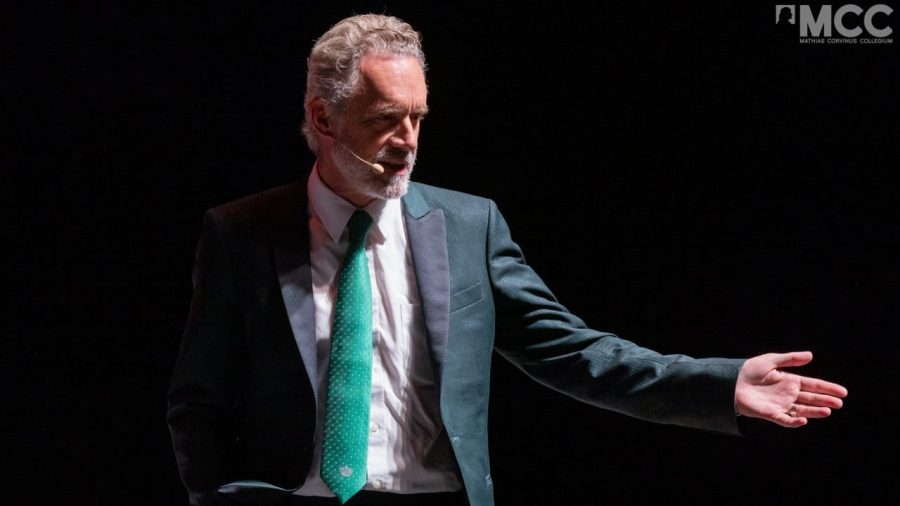Frontier Centre for Public Policy
How Canadians lost the rule of law

From the Frontier Centre for Public Policy
Universal problems are evident in the rejection of Jordan Peterson’s appeal against Ontario’s College of Psychologists (CPO) in Divisional Court. They had sought to re-educate him as a condition for retaining his license—because he openly ridiculed public figures. But as Dr. Peterson related in the National Post, October 11, they’ve failed to find a brainwasher for him.
Precedent now confirms that unaccountable tribunals may override apparent Charter rights. That may declare as unacceptable anyone’s contrary opinion or peaceful protest. Dr. Peterson’s case follows the way the courts clobbered supporters of the 2022 Freedom Convoy protest on Parliament Hill. Now members of all regulated professions are especially at risk, including doctors, lawyers and teachers. Instead of protecting citizens from overreach, the courts have become the instrument for enforcing tyranny.
As the Toronto Star reported on the first press conference by Chief Justice Richard Wagner in 2018, he said his court was “the most progressive in the world.” Today, progressive is synonymous with the absurdities that Dr. Peterson ridiculed. Wanjiru Njoya, a legal scholar at the University of Exeter has been quoted as saying that the courts automatically define as unreasonable any perspectives falling outside progressive boundaries.
A further foundational problem is that judges now routinely preside over cases where they have an obvious bias or personal connection, and then defer to those interests. Canadian judges should follow this admonition in the American Judicial Code? “Any justice, judge, or magistrate judge … shall disqualify himself in any proceeding in which his impartiality might reasonably be questioned.”
Justice Paul Schabas wrote the Decision for Dr. Peterson’s appeal before Divisional Court. However, he had previously been involved, personally, on the side of the argument opposite that of Dr. Peterson. In June 2018, as head of the Law Society of Ontario (LSO), he oversaw the imposition on lawyers of their controversial Statement of Principles (SOP). As a condition of licensing, it required a commitment to Equity, Social and (Corporate) Governance (ESG). Later, the LSO withdrew it following protests like African-Canadian Elias Munshya’s in Canadian Lawyer: “Lawyers play an essential role in our society; that role, however, does not include becoming state agents that parrot state-sponsored speech.”
Chief Justice Wagner recently confirmed that courts may now freely override common law precedent. He said that: “Apart from considering [historic] decisions as part of our legal cultural heritage, no one today will refer to a decision from 1892 to support his claim.” He added that “sometimes a decision from five years ago is an old decision ….”
Accordingly, the Supreme Court had simply disregarded century-old precedents when declaring Marc Nadon ineligible to join their club. My book Justice on Trial explains that many earlier appointments did not meet their newfound qualifications.
The subjective word “reasonable” supports much of Canada’s problematic jurisprudence. Absent objective criteria, judges reward friends and crush others as they may.
Justice Schabas said several comments similar to this one were unacceptable: “Dr. Peterson posted a tweet in May 2022, in which he commented on a Sports Illustrated Swimsuit Edition cover with a plus-sized model, saying: ‘Sorry. Not Beautiful. And no amount of authoritarian tolerance is going to change that.’”
Dr. Peterson objected that the CPO’s Code of Ethics should not constrain such “off duty opinions.” The Code says “[p]ersonal behaviour becomes a concern of the discipline only if it is of such a nature that it undermines public trust in the discipline as a whole or if it raises questions about the psychologist’s ability to carry out appropriately his/her responsibilities as a psychologist.” So which magazines’ cover pictures are not of public interest?
Justice Schabas continued, “The [CPO’s investigating] Panel also noted Dr. Peterson’s reliance on the Supreme Court’s decision in Grant v. Torstar, 2009 SCC 61, [2009] 3 SCR 640, a defamation case which held at para. 42, that “freedom of expression and respect for vigorous debate on matters of public interest have long been seen as fundamental to Canadian democracy … all Canadian laws must conform to it.” Why did Justice Schabas override this settled law?
Europe’s Charter of Fundamental Rights says, “Everyone has the right to freedom of expression. This right shall include freedom to hold opinions and to receive and impart information and ideas without interference by public authority and regardless of frontiers.” So how can a right be fundamental in other free and democratic countries but not in Canada?
And why did the court of Chief Justice Wagner decline to hear Dr. Peterson’s appeal and allow Justice Schabas’ decision to stand? No prize for your answer!
As long advocated by The Globe & Mail and The Toronto Star, Dr. Peterson’s case shows the need to end self-regulation and in-house discipline for lawyers and judges. That happened for lawyers for England and Wales in 2007. So why not in Canada?
Ottawa resident Colin Alexander’s latest books are Justice on Trial: Jordan Peterson’s case shows the need to fix a broken system; and Ballad of Sunny Ways: Popular traditional verse about living, loving and money.
Frontier Centre for Public Policy
Canada’s New Border Bill Spies On You, Not The Bad Guys

From the Frontier Centre for Public Policy
By Lee Harding
Lee Harding warns that the federal government’s so-called border bill lets officials snoop on your data, ban big cash payments and even open your mail – all without a warrant
Think Bill C-2 is about stopping fentanyl? Think again. It lets the feds snoop your data, open your mail and ban big cash payments – no warrant needed
The federal government is using the pretext of border security, the fentanyl crisis and transnational crime to push through Bill C-2, legislation that dangerously expands surveillance powers, undermines Canadians’ privacy and restricts financial freedom. This so-called Strong Borders Act is less about protecting borders and more about policing citizens.
Bill C-2, a 130-page omnibus bill introduced on June 3, grants broad new powers to government agencies to spy on Canadians and share personal information with foreign countries. A more honest title might be the Snoop and Gossip Act.
Among its most intrusive provisions, the bill would make it illegal for any business, profession or charity to accept cash payments over $10,000, even if made in smaller, related transactions. Want to pay a contractor $10,001 in five separate payments for home renovations? Too bad.
The Justice Centre for Constitutional Freedoms quickly condemned the move. “Restricting the use of cash is a dangerous step toward tyranny and totalitarianism,” the organization posted to X. “Cash gives citizens privacy, autonomy, and freedom from surveillance by government and by banks.”
Under Bill C-2, internet service providers could be compelled—under threat of fines—to hand over names, locations and “pseudonyms” of users without a warrant. Any peace officer or public officer can demand this data by merely claiming “reasonable grounds to suspect” an offence “has been or will be committed.”
It doesn’t stop there. The bill would also authorize the government to open private mail under the same vague threshold of suspicion.
Experts in law and privacy say the bill is a massive overreach. University of Ottawa internet law scholar Michael Geist and Kate Robertson of the University of Toronto’s Citizen Lab both point out that successive federal governments have sought to expand internet surveillance for years, but Bill C-2 goes further than ever before.
“Bill C-2’s big brother tactics combine expansive warrantless disclosure with unprecedented secrecy,” Geist warns. He adds that the bill “overreaches by including measures on internet subscriber data that have nothing to do with border safety or security but raise privacy and civil liberties concerns.”
If the intent were truly to combat fentanyl trafficking and transnational crime, better tools already exist. Conservative MP Frank Caputo pointed out that the bill has 16 parts but says nothing about increasing penalties or jail time for fentanyl traffickers.
“There is nothing about bail in the bill,” Caputo said during early debate on the bill. “In this omnibus bill, it says that offenders can serve their sentence for trafficking in fentanyl from their couch.”
Bloc Québécois MP Claude DeBellefeuille argued that strengthening border security requires more boots on the ground. Two rural border crossings in her riding recently had their staffed hours cut in half.
“It is estimated that the CBSA (Canada Border Services Agency) already has a shortage of between 2,000 and 3,000 border services officers for current duties. If they are given new responsibilities, however necessary, there will be an even greater shortage,” she said.
Not only does Bill C-2 contradict Supreme Court precedent. It also sets the stage for Canada to share sensitive personal information with foreign governments. In 2014, the court ruled that Canadians have a “reasonable expectation of privacy in the subscriber information” provided to internet service providers and that police requests for such data amount to a “search” requiring a warrant.
Robertson warns that the bill not only defies this precedent but also enables Canada to share this dubiously acquired information with 49 other countries under the Second Additional Protocol to the Cybercrime Convention. Canada signed the agreement in 2023 but hasn’t ratified it. Bill C-2 would make that possible.
She calls the protocol’s weak human rights safeguards “a direct threat to existing protections under international human rights law.” Robertson co-authored a submission urging the Department of Justice to reject the 2AP and instead support data-sharing frameworks that are built on consistent rights protections across all signatories.
Further complicating matters, Canada is in negotiations with the United States over a data-sharing agreement under that country’s CLOUD Act. Canada’s willingness to comply may reflect lingering trade pressures from the Trump administration, pressures that could again push Canada to compromise its legal independence and citizens’ rights.
This bill should be scrapped or thoroughly revised. Canadians should not have to surrender their privacy and human rights to serve a global law enforcement agenda that disregards civil liberties. If the line between national security and authoritarianism is erased, the greatest threat to Canadians may no longer be drug traffickers—it may be their own government.
Lee Harding is a research fellow at the Frontier Centre for Public Policy.
Frontier Centre for Public Policy
New Book Warns The Decline In Marriage Comes At A High Cost

From the Frontier Centre for Public Policy
Travis Smith reviews I… Do? by Andrea Mrozek and Peter Jon Mitchell, showing that marriage is a public good, not just private choice, arguing culture, not politics, must lead any revival of this vital institution.
Andrea Mrozek and Peter Jon Mitchell, in I… Do?, write that the fading value of marriage is a threat to social stability
I… Do? by Andrea Mrozek and Peter Jon Mitchell manages to say something both obvious and radical: marriage matters. And not just for sentimental reasons. Marriage is a public good, the authors attest.
The book is a modestly sized but extensively researched work that compiles decades of social science data to make one central point: stable marriages improve individual and societal well-being. Married people are generally healthier, wealthier and more resilient. Children from married-parent homes do better across almost every major indicator: academic success, mental health, future earnings and reduced contact with the justice system.
The authors refer to this consistent pattern as the “marriage advantage.” It’s not simply about income. Even in low-income households, children raised by married parents tend to outperform their peers from single-parent families. Mrozek and Mitchell make the case that marriage functions as a stabilizing institution, producing better outcomes not just for couples and kids but for communities and, by extension, the country.
While the book compiles an impressive array of empirical findings, it is clear the authors know that data alone can’t fix what’s broken. There’s a quiet but important concession in these pages: if statistics alone could persuade people to value marriage, we would already be seeing a turnaround.
Marriage in Canada is in sharp decline. Fewer people are getting married, the average age of first marriage continues to climb, and fertility rates are hitting historic lows. The cultural narrative has shifted. Marriage is seen less as a cornerstone of adult life and more as a personal lifestyle choice, often put off indefinitely while people wait to feel ready, build their careers or find emotional stability.
The real value of I… Do? lies in its recognition that the solutions are not primarily political. Policy changes might help stop making things worse, but politicians are not going to rescue marriage. In fact, asking them to may be counterproductive. Looking to politicians to save marriage would involve misunderstanding both marriage and politics. Mrozek and Mitchell suggest the best the state can do is remove disincentives, such as tax policies and benefit structures that inadvertently penalize marriage, and otherwise get out of the way.
The liberal tradition once understood that family should be considered prior to politics for good reason. Love is higher than justice, and the relationships based in it should be kept safely outside the grasp of bureaucrats, ideologues, and power-seekers. The more marriage has been politicized over recent decades, the more it has been reshaped in ways that promote dependency on the impersonal and depersonalizing benefactions of the state.
The book takes a brief detour into the politics of same-sex marriage. Mrozek laments that the topic has become politically untouchable. I would argue that revisiting that battle is neither advisable nor desirable. By now, most Canadians likely know same-sex couples whose marriages demonstrate the same qualities and advantages the authors otherwise praise.
Where I… Do? really shines is in its final section. After pages of statistics, the authors turn to something far more powerful: culture. They explore how civil society—including faith communities, neighbourhoods, voluntary associations and the arts can help revive a vision of marriage that is compelling, accessible and rooted in human experience. They point to storytelling, mentorship and personal witness as ways to rebuild a marriage culture from the ground up.
It’s here that the book moves from description to inspiration. Mrozek and Mitchell acknowledge the limits of top-down efforts and instead offer the beginnings of a grassroots roadmap. Their suggestions are tentative but important: showcase healthy marriages, celebrate commitment and encourage institutions to support rather than undermine families.
This is not a utopian manifesto. It’s a realistic, often sobering look at how far marriage has fallen off the public radar and what it might take to put it back. In a political climate where even mentioning marriage as a public good can raise eyebrows, I… Do? attempts to reframe the conversation.
To be clear, this is not a book for policy wonks or ideologues. It’s for parents, educators, community leaders and anyone concerned about social cohesion. It’s for Gen Xers wondering if their children will ever give them grandchildren. It’s for Gen Zers wondering if marriage is still worth it. And it’s for those in between, hoping to build something lasting in a culture that too often encourages the opposite.
If your experiences already tell you that strong, healthy marriages are among the greatest of human goods, I… Do? will affirm what you know. If you’re skeptical, it won’t convert you overnight, but it might spark a much-needed conversation.
Travis D. Smith is an associate professor of political science at Concordia University in Montreal. This book review was submitted by the Frontier Centre for Public Policy.
-

 Business1 day ago
Business1 day agoMark Carney’s Fiscal Fantasy Will Bankrupt Canada
-

 Opinion1 day ago
Opinion1 day agoCharity Campaigns vs. Charity Donations
-

 Alberta1 day ago
Alberta1 day agoTemporary Alberta grid limit unlikely to dampen data centre investment, analyst says
-

 Daily Caller21 hours ago
Daily Caller21 hours ago‘Strange Confluence Of Variables’: Mike Benz Wants Transparency Task Force To Investigate What Happened in Butler, PA
-

 Frontier Centre for Public Policy2 days ago
Frontier Centre for Public Policy2 days agoCanada’s New Border Bill Spies On You, Not The Bad Guys
-

 Uncategorized2 days ago
Uncategorized2 days agoCNN’s Shock Climate Polling Data Reinforces Trump’s Energy Agenda
-

 Opinion1 day ago
Opinion1 day agoPreston Manning: Three Wise Men from the East, Again
-

 Business1 day ago
Business1 day agoCarney Liberals quietly award Pfizer, Moderna nearly $400 million for new COVID shot contracts


